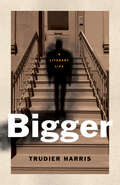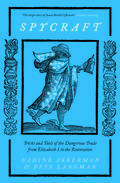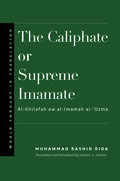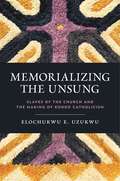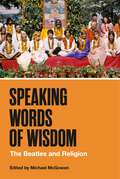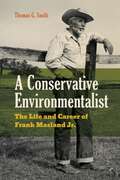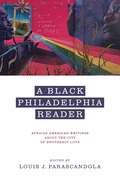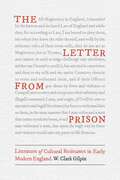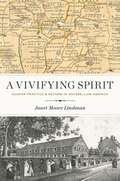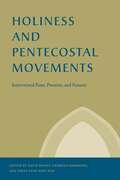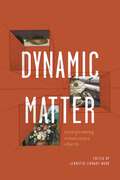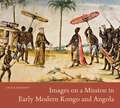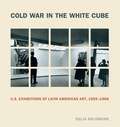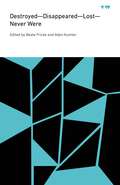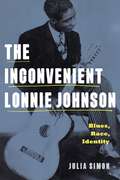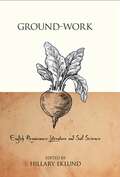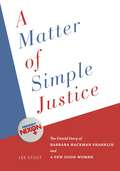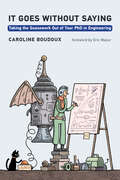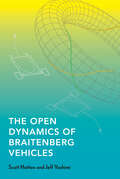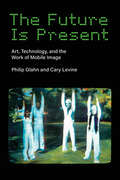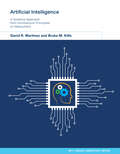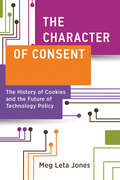- Table View
- List View
Bigger: A Literary Life (Black Lives)
by Trudier HarrisA biography of Native Son&’s Bigger Thomas that examines his continued relevance in debates over Black men and the violence of racism Bigger Thomas, the central figure in Richard Wright&’s novel Native Son (1940), eludes easy categorization. A violent and troubled character who rejects the rules of society, Bigger is both victim and perpetrator, damaged by racism and segregation on the South Side of Chicago, seemingly raping and killing without regrets. His story has electrified readers for more than eight decades, and it continues to galvanize debates around representation, respectability, social justice, and racism in American life. In this book, distinguished scholar Trudier Harris examines the literary life of Bigger Thomas from his birth to the current day. Harris explores the debates between Black critics and Communist artists in the 1930s and 1940s over the &“political novel,&” the censorship of Native Son by white publishers, and the work&’s initial reception—as well as interpretations from Black feminists and Black Power activists in the decades that followed, up to the novel&’s resonance with the Black Lives Matter movement today. Bigger, Harris argues, represents the knotted heart of American racism, damning and unsettling, and still very much with us.
Spice: The 16th-Century Contest that Shaped the Modern World
by Roger CrowleyThe story of the sixteenth-century&’s epic contest for the spice trade, which propelled European maritime exploration and conquest across Asia and the Pacific Spices drove the early modern world economy, and for Europeans they represented riches on an unprecedented scale. Cloves and nutmeg could reach Europe only via a complex web of trade routes, and for decades Spanish and Portuguese explorers competed to find their elusive source. But when the Portuguese finally reached the spice islands of the Moluccas in 1511, they set in motion a fierce competition for control. Roger Crowley shows how this struggle shaped the modern world. From 1511 to 1571, European powers linked up the oceans, established vast maritime empires, and gave birth to global trade, all in the attempt to control the supply of spices. Taking us on voyages from the dockyards of Seville to the vastness of the Pacific, the volcanic Spice Islands of Indonesia, the Arctic Circle, and the coasts of China, this is a narrative history rich in vivid eyewitness accounts of the adventures, shipwrecks, and sieges that formed the first colonial encounters—and remade the world economy for centuries to follow.
Spycraft: Tricks and Tools of the Dangerous Trade from Elizabeth I to the Restoration
by Pete Langman Nadine AkkermanA fascinating exploration of the devious tricks and ingenious tools used by early modern spies—from ciphers to counterfeiting, invisible inks to assassination Early modern Europe was a hotbed of espionage, where spies, spy-catchers, and conspirators pitted their wits against each other in deadly games of hide and seek. Theirs was a dangerous trade—only those who mastered the latest techniques would survive. In this engaging, accessible account, Nadine Akkerman and Pete Langman explore the methods spies actually used in the period, including disguises, invisible inks, and even poisons. Drawing on a vast array of archival sources, they show how understanding the tricks and tools of espionage allows us to re-imagine well-known stories such as the Babington and Gunpowder plots. Exposing the murky world of spies, they demonstrate how the technological innovations of petty criminals, secretaries, and other hitherto invisible actors shaped the fate of some of history&’s most iconic figures. Spycraft explains how early modern spies sought to protect their own secrets while exposing those of their enemies, showing the reader how to follow in their footsteps.
Spain: The Trials and Triumphs of a Modern European Country
by Michael ReidAn incisive account of modern Spain, from the death of Franco to the Catalan referendum and beyond “Comprehensive and engaging.”—Gideon Rachman, Financial Times Spain’s transition to democracy after Franco’s long dictatorship was widely hailed as a success, ushering in three decades of unprecedented progress and prosperity. Yet over the past decade its political consensus has been under severe strain. A stable two-party system has splintered, with disruptive new parties on the far left and far right. No government has had a majority since 2015. Michael Reid overturns the stereotypical view of Spain as a country haunted by its Francoist past. From Catalan separatism and the indignados movement to the Spanish economy’s overdependence on tourism and small business, Spain’s challenges can often seem unique. But Reid is careful to emphasize the many pressures it faces in common with its European neighbors—such as austerity, populism, and increasing polarization. The result is a penetrating yet rounded portrait of a vibrant country—one that is more often visited than understood.
The Caliphate or Supreme Imamate (World Thought in Translation)
by Muhammad Rashid RidaA translation of Muhammad Rashid Rida&’s best-known work, which examines the compatibility of Islamic political and legal tradition with modern thought Muhammad Rashid Rida (1865–1935) was a prominent Muslim intellectual and reformer. Born in a village near Tripoli in present-day Lebanon, he was renowned for his founding of Al-Manar, an independent and successful Islamic magazine in which he published The Caliphate or Supreme Imamate as a series beginning in 1922. The work showcased Rida&’s faith in the Islamic tradition as the origin of notions such as self-determination and popular sovereignty, as well as his opposition to Western politics. A realist, he nevertheless argued that a revived Caliphate was viable and held the keys to Muslim empowerment and universal salvation. This skillful translation by Simon A. Wood will make The Caliphate or Supreme Imamate accessible for the first time to English-speaking scholars and students of political theory and the modern Middle East.
Memorializing the Unsung: Slaves of the Church and the Making of Kongo Catholicism (World Christianity)
by Elochukwu Uzukwu, C.S.Sp.By the time the Capuchins arrived in the seventeenth century, Kongo had been Catholic for nearly two hundred years. The European mission could not be conversion, then, but reinforcement; the Capuchins sought to establish the sacraments and a line to Rome in a lay-led church already suffused with an enduring, creative, and complex theological culture. In Memorializing the Unsung, Elochukwu Uzukwu uses the framework of this “ancient” Kongo Catholicism to explore European dependence on enslaved Kongo Catholics and the unconscionable Capuchin and Spiritan participation in the slave trade at large—a practice denounced by the lone voices of Capuchin Epifanio de Moirans and Spiritan Alexandre Monnet. Reconstructing the church that missionaries and Kongo Catholics built together on the foundations of local religion, Memorializing the Unsung contrasts the dignity denied the Kongo Catholics with the freedom they nonetheless performed. Uzukwu is particularly deft in tracing the agency of Kongo elites and laypeople from the fifteenth century through the nineteenth, carefully evaluating their deliberate engagements with southern Europeans, the role of the maestri (translator-catechists) in guiding the faithful, and the ultimate development of a unique theological vocabulary endorsed by the Kikongo catechism.Without the support and creativity of these unsung lay Catholics across west-central and eastern Africa, Uzukwu shows, the European missions in the region would have failed. Even while enslaved, the Kongo Slaves of the Church and the eastern African Slaves of the Mission served as mediators, co-creators, and reinventors of their world.
Speaking Words of Wisdom: The Beatles and Religion (American Music History)
by Michael McGowan“More popular than Jesus.”Despite the uproar it caused in America in 1966, John Lennon’s famous assessment of the Beatles vis-à-vis religion was not far off. The Beatles did mean more to kids than the religions in which they were raised, not only in America but everywhere in the world.By all accounts, the Beatles were the most significant musical group of the twentieth century. Their albums sold in the hundreds of millions, and the press was always eager to document their activities and perspectives. And when fan appreciation morphed into worship, Beatlemania took on religious significance. Many young people around the world began to look to the Beatles—their music, their commentary, their art—for meaning in a turbulent decade. Speaking Words of Wisdom is a deep dive into the Beatles’ relationship to religion through the lenses of philosophy, cultural studies, music history, and religious studies. Chapters explore topics such as religious life in Liverpool, faith among individual band members, why and how India entered the Beatles’ story, fan worship/deification, and the Beatles’ long-lasting legacy. In the 1960s, the Beatles facilitated a reevaluation of our deepest values. The story of how the Beatles became modern-day sages is an important case study for the ways in which consumers make culturally and religiously significant meaning from music, people, and events.In addition to the editor, the contributors to this book include David Bedford, Kenneth Campbell, John Covach, Melissa Davis, Anthony DeCurtis, Mark Duffett, Scott Freer, Murray Leeder, Sean MacLeod, Grant Maxwell, Christiane Meiser, and Eyal Regev.
A Conservative Environmentalist: The Life and Career of Frank Masland Jr.
by Thomas G. SmithA wealthy textile titan from Carlisle, Pennsylvania, Frank Masland Jr. was an ardent political conservative and an equally fervent conservationist who was well known and highly respected in the mid-twentieth-century environmental preservation community. This eye-opening biography charts Masland’s life work, telling the story of how he and fellow Republicans worked with Democrats to expand the national park system, preserve wild country, and protect the environment. Though a conservative conservationist appears to be a contradiction in terms today, this was not necessarily the case when Masland and his compatriots held sway. Conservatives, Masland insisted, had a duty to be good stewards of the earth for present and future generations, and they worked closely with members of both parties in Congress and nonpolitical conservation groups to produce landmark achievements. When conservatives turned against environmentalism during the Reagan presidency, Masland refused to join what historians have termed the “Republican reversal.” During his long life of nearly a hundred years, Masland used his voice, influence, experiences with nature, and considerable wealth to champion environmental causes at the national, state, and local levels. Engaging, informative, and at times eyebrow-raising, this portrait of a passionately anti-statist nature-loving Republican environmentalist documents the history of the twentieth-century conservation movement and reminds us of a time when conservative Republicans could work with liberal Democrats to protect the environment.
A Black Philadelphia Reader: African American Writings About the City of Brotherly Love
by Louis J. ParascandolaThe relationship between the City of Brotherly Love and its Black residents has been complicated from the city’s founding through the present day. A Black Philadelphia Reader traces this complex history in the words of Black writers who were native to, lived in, or had significant connections to the city. Featuring the works of famous authors—including W. E. B. Du Bois, Harriet Jacobs, Sonia Sanchez and John Edgar Wideman—alongside lesser-known voices, this reader is an immersive and enriching composite portrait of the Black experience in Philadelphia. Through fiction and nonfiction, poetry and prose, readers witness episodes of racial prejudice and gender inequality in areas like public health, housing, education, policing, criminal justice, and public transportation. And yet amid these myriad challenges, the writers convey an enduring faith, a love of family and community, and a hope that Philadelphia will fulfill its promises to its Black citizens.Thoughtfully introduced and accompanied by notes that contextualize the works and aid readers’ comprehension, this book will appeal to a wide audience of Philadelphians and other readers interested in American, African American, and urban studies.
The Letter from Prison: Literature of Cultural Resistance in Early Modern England
by W. Clark GilpinLetters from prison testifying to deeply felt ethical principles have a long history, extending from antiquity to the present day. In the early modern era, the rise of printing houses helped turn these letters into a powerful form of political and religious resistance. W. Clark Gilpin’s fascinating book examines how letter writers in England—ranging from archbishops to Quaker women—consolidated the prison letter as a literary form.Drawing from a large collection of printed prison letters written from the reign of Henry VIII to the closing decades of the seventeenth century, Gilpin explores the genre's many facets within evolving contexts of reformation and revolution. The writers of these letters portrayed the prisoner of conscience as a distinct persona and the prison as a place of redemptive suffering where bearing witness had the power to change society.The Letter from Prison features a diverse cast of characters and a literary genre that combines drama and inspiration. It is sure to appeal to those interested in early modern England, prison literature, and cultural forms of resistance.
A Vivifying Spirit: Quaker Practice and Reform in Antebellum America
by Janet Moore LindmanAmerican Quakerism changed dramatically in the antebellum era owing to both internal and external forces, including schism, industrialization, western migration, and reform activism. With the “Great Separation” of the 1820s and subsequent divisions during the 1840s and 1850s, new Quaker sects emerged. Some maintained the quietism of the previous era; others became more austere; still others were heavily influenced by American evangelicalism and integration into modern culture. Examining this increasing complexity and highlighting a vital religiosity driven by deeply held convictions, Janet Moore Lindman focuses on the Friends of the mid-Atlantic and the Delaware Valley to explore how Friends’ piety affected their actions—not only in the evolution of religious practice and belief but also in response to a changing social and political context. Her analysis demonstrates how these Friends’ practical approach to piety embodied spiritual ideals that reformulated their religion and aided their participation in a burgeoning American republic.Based on extensive archival research, this book sheds new light on both the evolution of Quaker spiritual practice and the history of antebellum reform movements. It will be of interest to scholars and students of early American history, religious studies, and Quaker studies as well as general readers interested in the history of the Society of Friends.
Holiness and Pentecostal Movements: Intertwined Pasts, Presents, and Futures (Studies in the Holiness and Pentecostal Movements)
by David Bundy, Geordan Hammond, and David Sang-Ehil HanSince the 1830s, Holiness and Pentecostal movements have had a significant influence on many Christian churches, and they have been a central force in producing what is known today as World Christianity. This book demonstrates the advantages of analyzing them in relation to one another.The Salvation Army, the Church of the Nazarene, the Wesleyan Church, and the Free Methodist Church identify strongly with the Holiness Movement. The Assemblies of God and the Pentecostal Assemblies of the World identify just as strongly with the Pentecostal Movement. Complicating matters, denominations such as the Church of God (Cleveland), the International Holiness Pentecostal Church, and the Church of God in Christ have harmonized Holiness and Pentecostalism. This book, the first in the new series Studies in the Holiness and Pentecostal Movements, examines these complex relationships in a multidisciplinary fashion. Building on previous scholarship, the contributors provide new ways of understanding the relationships, influences, and circulation of ideas among these movements in the United States, the United Kingdom, India, and Southeast and East Asia.In addition to the editors, the contributors are Kimberly Ervin Alexander, Insik Choi, Robert A. Danielson, Chris E. W. Green, Henry H. Knight III, Frank D. Macchia, Luther Oconer, Cheryl J. Sanders, and Daniel Woods.
Dynamic Matter: Transforming Renaissance Objects (Cultural Inquiries in English Literature, 1400–1700)
by Jennifer Linhart WoodDynamic Matter investigates the life histories of Renaissance objects. Eschewing the critical tendency to study how objects relate to human needs and desires, this work foregrounds the objects themselves, demonstrating their potential to transform their environments as they travel across time and space.Integrating early modern material theories with recent critical approaches in Actor-Network Theory and object-oriented ontology, this volume extends Aristotle’s theory of dynameos—which conceptualizes matter as potentiality—and applies it to objects featured in early modern texts such as Edmund Spenser’s The Faerie Queene, Robert Hooke’s Micrographia, and William Shakespeare’s The Tempest. Individual chapters explore the dynameos of matter by examining its manifestations in particular forms: combs are inscribed with words and brushed through human hair; feathers are incorporated into garments and artwork; Prince Rupert’s glasswork drops explode; a whale becomes animated by the power of a magical bracelet; and books are drowned. These case studies highlight the potentiality matter itself possesses and that which it activates in other matter. A theorization of objects grounded in Renaissance materialist thought, Dynamic Matter examines the richness of things themselves; the larger, multiple, and changing networks in which things circulate; and the networks created by these transformative objects.In addition to the editor, the contributors to this volume include Anna Riehl Bertolet, Erika Mary Boeckeler, Naomi Howell, Emily E. F. Philbrick, Josie Schoel, Maria Shmygol, Edward McLean Test, Abbie Weinberg, and Sarah F. Williams.
Images on a Mission in Early Modern Kongo and Angola
by Cécile FromontEarly modern central Africa comes to life in an extraordinary atlas of vivid watercolors and drawings that Italian Capuchin Franciscans, veterans of Kongo and Angola missions, composed between 1650 and 1750 for the training of future missionaries. These “practical guides” present the intricacies of the natural, social, and religious environment of seventeenth- and eighteenth-century west-central Africa and outline the primarily visual catechization methods the friars devised for the region. Images on a Mission in Early Modern Kongo and Angola brings this overlooked visual corpus to public and scholarly attention.This beautifully illustrated book includes full-color reproductions of all the images in the atlas, in conjunction with rarely seen related material gathered from collections and archives around the world. Taking a bold new approach to the study of early modern global interactions, art historian Cécile Fromont demonstrates how visual creations such as the Capuchin vignettes, though European in form and crafstmanship, emerged not from a single perspective but rather from cross-cultural interaction. Fromont models a fresh way to think about images created across cultures, highlighting the formative role that cultural encounter itself played in their conception, execution, and modes of operation.Centering Africa and Africans, and with ramifications on four continents, Fromont’s decolonial history profoundly transforms our understanding of the early modern world. It will be of substantial interest to specialists in early modern studies, art history, and religion.
Cold War in the White Cube: U.S. Exhibitions of Latin American Art, 1959–1968 (Refiguring Modernism)
by Delia SolomonsIn 1959, the very year the Cuban Revolution amplified Cold War tensions in the Americas, museumgoers in the United States witnessed a sudden surge in major exhibitions of Latin American art. Surveying the 1960s boom of such exhibits, this book documents how art produced in regions considered susceptible to communist influence was staged on U.S. soil for U.S. audiences.Held in high-profile venues such as the Guggenheim Museum, the Walker Art Center, MoMA, and the Art Institute of Chicago, the exhibitions of the 1960s Latin American art boom did not define a single stylistic trend or the art of a single nation but rather attempted to frame Latin America as a unified whole for U.S. audiences. Delia Solomons calls attention to disruptive artworks that rebelled against the curatorial frames purporting to hold them and reveals these exhibitions to be complex contact zones in which competing voices collided. Ultimately, through multiple means—including choosing to exclude artworks with readily decipherable political messages and evading references to contemporary inter-American frictions—the U.S. curators who organized these shows crafted projections of Pan-American partnership and harmony, with the United States as leader, interpreter, and good neighbor, during an era of brutal U.S. interference across the Americas.Theoretically sophisticated and highly original, this survey of Cold War–era Latin American art exhibits sheds light on the midcentury history of major U.S. art museums and makes an important contribution to the fields of museum studies, art history, and Latin American modernist art.
Destroyed—Disappeared—Lost—Never Were (ICMA Books | Viewpoints)
by Beate Fricke and Aden KumlerTo write about works that cannot be sensually perceived involves considerable strain. Absent the object, art historians must stretch their methods to, or even past, the breaking point. This concise volume addresses the problems inherent in studying medieval works of art, artifacts, and monuments that have disappeared, have been destroyed, or perhaps never existed in the first place.The contributors to this volume are confronted with the full expanse of what they cannot see, handle, or know. Connecting object histories, the anthropology of images, and historiography, they seek to understand how people have made sense of the past by examining objects, images, and architectural and urban spaces. Intersecting these approaches is a deep current of reflection upon the theorization of historical analysis and the ways in which the past is inscribed into layers of evidence that are only ever revealed in the historian’s present tense.Highly original and theoretically sophisticated, this volume will stimulate debate among art historians about the critical practices used to confront the formative presence of destruction, loss, obscurity, and existential uncertainty within the history of art and the study of historical material and visual cultures.In addition to the editors, the contributors to this volume are Michele Bacci, Claudia Brittenham, Sonja Drimmer, Jaś Elsner, Peter Geimer, Danielle B. Joyner, Kristopher W. Kersey, Lena Liepe, Meekyung MacMurdie, and Michelle McCoy.
The Inconvenient Lonnie Johnson: Blues, Race, Identity (American Music History)
by Julia SimonLonnie Johnson is a blues legend. His virtuosity on the blues guitar is second to none, and his influence on artists from T-Bone Walker and B. B. King to Eric Clapton is well established. Yet Johnson mastered multiple instruments. He recorded with jazz icons such as Duke Ellington and Louis Armstrong, and he played vaudeville music, ballads, and popular songs.In this book, Julia Simon takes a closer look at Johnson’s musical legacy. Considering the full body of his work, Simon presents detailed analyses of Johnson’s music—his lyrics, technique, and styles—with particular attention to its sociohistorical context. Born in 1894 in New Orleans, Johnson's early experiences were shaped by French colonial understandings of race that challenge the Black-white binary. His performances call into question not only conventional understandings of race but also fixed notions of identity. Johnson was able to cross generic, stylistic, and other boundaries almost effortlessly, displaying astonishing adaptability across a corpus of music produced over six decades. Simon introduces us to a musical innovator and a performer keenly aware of his audience and the social categories of race, class, and gender that conditioned the music of his time. Lonnie Johnson’s music challenges us to think about not only what we recognize and value in “the blues” but also what we leave unexamined, cannot account for, or choose not to hear. The Inconvenient Lonnie Johnson provides a reassessment of Johnson’s musical legacy and complicates basic assumptions about the blues, its production, and its reception.
Ground-Work: English Renaissance Literature and Soil Science (Medieval & Renaissance Literary Studies)
by Hillary EklundHow does soil, as an ecological element, shape culture? With the sixteenth-century shift in England from an agrarian economy to a trade economy, what changes do we see in representations of soil as reflected in the language and stories during that time? This collection brings focused scholarly attention to conceptions of soil in the early modern period, both as a symbol and as a feature of the physical world, aiming to correct faulty assumptions that cloud our understanding of early modern ecological thought: that natural resources were then poorly understood and recklessly managed, and that cultural practices developed in an adversarial relationship with natural processes. Moreover, these essays elucidate the links between humans and the lands they inhabit, both then and now.
A Matter of Simple Justice: The Untold Story of Barbara Hackman Franklin and a Few Good Women
by Lee StoutIn August 1972, Newsweek proclaimed that “the person in Washington who has done the most for the women’s movement may be Richard Nixon.” Today, opinions of the Nixon administration are strongly colored by foreign policy successes and the Watergate debacle. Its accomplishments in advancing the role of women in government have been largely forgotten. Based on the “A Few Good Women” oral history project at the Penn State University Libraries, A Matter of Simple Justice illuminates the administration’s groundbreaking efforts to expand the role of women—and the long-term consequences for women in the American workplace. At the forefront of these efforts was Barbara Hackman Franklin, a staff assistant to the president who was hired to recruit more women into the upper levels of the federal government. Franklin, at the direction of President Nixon, White House counselor Robert Finch, and personnel director Fred Malek, became the administration’s de facto spokesperson on women’s issues. She helped bring more than one hundred women into executive positions in the government and created a talent bank of more than a thousand names of qualified women. The Nixon administration expanded the numbers of women on presidential commissions and boards, changed civil service rules to open thousands more federal jobs to women, and expanded enforcement of antidiscrimination laws to include gender discrimination. Also during this time, Congress approved the Equal Rights Amendment and Nixon signed Title IX of the Education Amendments into law. The story of Barbara Hackman Franklin and those “few good women” shows how the advances that were made in this time by a Republican presidency both reflected the national debate over the role of women in society and took major steps toward equality in the workplace for women.
Feminist Interpretations of Plato
by Nancy TuanaThe essays in this anthology explore the full spectrum of Plato's philosophy and are representative of the variety of perspectives within feminist criticism. The essays in the first section focus primarily on Plato's social and political theory, and in particular the place of women within the state. The second section concentrates on examining the role of the feminine within Plato's metaphysics and epistemology. Tuana introduces both sections and a detailed bibliography is included.
It Goes without Saying: Taking the Guesswork Out of Your PhD in Engineering
by Caroline BoudouxThe definitive toolkit for doctoral students in engineering on thesis—and journal article—preparation, project (and stress) management, IP protection, collaborations, and other aspects of the PhD journey.It shouldn't take a PhD to get a PhD, but sometimes the process can seem that confusing—even though, to the mentors and advisors, so obvious that it goes without saying. For doctoral students in engineering confronting this dilemma, Caroline Boudoux, an accomplished researcher and entrepreneur, provides a demystifying guide to the challenges—daunting, seemingly routine, and at times unexpected—of pursuing a PhD in this demanding field. In It Goes without Saying, Boudoux marshals her considerable experience mentoring graduate students, teaching doctoral workshops, and—not so long ago—earning her own PhD at MIT to give PhD candidates the know-how, and the confidence, to succeed.Among the topics this book takes up are: What a PhD is: the journey, the milestones, and the endgame.Technical questions about what a doctoral project in engineering is and how to lead one.Practical matters including tips on writing, from proposal to dissertation; ethics; and intellectual property.Personal concerns, such as dealing with expectations, imposter syndrome, and stress.From the mundane to the metaphysical, this user-friendly guide gives the doctoral student in engineering the tools to make it from Day 1 to the successful completion of the PhD in a timely, fully informed, and forward-looking manner.
The Open Dynamics of Braitenberg Vehicles
by Jeff Yoshimi Scott HottonAn introduction to dynamical systems theory, a detailed mathematical analysis of pairs of Braitenberg vehicles, and a look at how these results apply to the study of physical and biological organisms.Powering the concept of a Braitenberg vehicle, developed in 1984 by the Italian-Austrian cyberneticist Valentino Braitenberg, is the idea that simple systems can produce complex behaviors. A pair of interacting Braitenberg vehicles is simple, but they can meander, wind around, and follow each another in a number of ways. In this book, Scott Hotton and Jeff Yoshimi show how dynamical systems theory—in particular the theory of open dynamic systems—can be used to analyze pairs of these vehicles in great detail. The result of the authors&’ long-standing collaboration at the intersection of mathematics, philosophy, cognitive science, and biology, The Open Dynamics of Braitenberg Vehicles offers a rigorous mathematical foundation for embodied cognition, especially when it comes to two-way interactions between an agent and its environment.Following an introduction to dynamical systems theory, and the most detailed mathematical analysis of Braitenberg vehicles to date, Hotton and Yoshimi discuss how their results can be applied to the study of physical and biological systems. They also describe their work's relevance to debates in the philosophy of embodied cognitive science. Combining the best features of embodied and representational approaches to cognitive science, complete with code and simulations, The Open Dynamics of Braitenberg Vehicles provides an extremely accessible and visually rich look into the workings and applications of open dynamical systems.
The Future Is Present: Art, Technology, and the Work of Mobile Image (Leonardo)
by Cary Levine Philip GlahnA critical history of the pioneering art and technology group Mobile Image and their prescient work in communications, networking, and information systems.In The Future Is Present, Philip Glahn and Cary Levine tell the fascinating history of the visionary art group Mobile Image—founded by Kit Galloway and Sherrie Rabinowitz in 1977—which appropriated emerging technologies, from satellites to electronic message platforms. Based in Los Angeles, this under-studied collective worked amid urban crisis, a techno-boom, consolidating media power, and ascendant neoliberal politics. Mobile Image challenged fundamental conventions of the public sphere, democracy, communication, and political participation, as well as notions of power, representation, and identity.Glahn and Levine argue not only for the historical importance of Mobile Image, but also for a critical artistic process that is at once analytic and transformative. They weave themes such as embodiment and its mediation, public/private dialectics, and techno-utopian vision throughout the book, binding these projects to discourses around race, gender, and class, as well as margin and center, the local and the global. In today&’s world of ubiquitous digital re/production, networking, and social media, The Future Is Present shows how the work of Mobile Image continues to have profound implications for art, technology, and the politics of public and private experience.
Artificial Intelligence: A Systems Approach from Architecture Principles to Deployment (MIT Lincoln Laboratory Series)
by David R. Martinez Bruke M. KifleThe first text to take a systems engineering approach to artificial intelligence (AI), from architecture principles to the development and deployment of AI capabilities.Most books on artificial intelligence (AI) focus on a single functional building block, such as machine learning or human-machine teaming. Artificial Intelligence takes a more holistic approach, addressing AI from the view of systems engineering. The book centers on the people-process-technology triad that is critical to successful development of AI products and services. Development starts with an AI design, based on the AI system architecture, and culminates with successful deployment of the AI capabilities. Directed toward AI developers and operational users, this accessibly written volume of the MIT Lincoln Laboratory Series can also serve as a text for undergraduate seniors and graduate-level students and as a reference book. Key features:In-depth look at modern computing technologies Systems engineering description and means to successfully undertake an AI product or service development through deploymentExisting methods for applying machine learning operations (MLOps)AI system architecture including a description of each of the AI pipeline building blocksChallenges and approaches to attend to responsible AI in practice Tools to develop a strategic roadmap and techniques to foster an innovative team environment Multiple use cases that stem from the authors&’ MIT classes, as well as from AI practitioners, AI project managers, early-career AI team leaders, technical executives, and entrepreneurs Exercises and Jupyter notebook examples
The Character of Consent: The History of Cookies and the Future of Technology Policy (Information Policy)
by Meg Leta JonesThe rich, untold origin story of the ubiquitous web cookie—what&’s wrong with it, why it&’s being retired, and how we can do better.Consent pop-ups continually ask us to download cookies to our computers, but is this all-too-familiar form of privacy protection effective? No, Meg Leta Jones explains in The Character of Consent, rather than promote functionality, privacy, and decentralization, cookie technology has instead made the internet invasive, limited, and clunky. Good thing, then, that the cookie is set for retirement in 2024. In this eye-opening book, Jones tells the little-known story of this broken consent arrangement, tracing it back to the major transnational conflicts around digital consent over the last twenty-five years. What she finds is that the policy controversy is not, in fact, an information crisis—it&’s an identity crisis.Instead of asking how people consent, Jones asks who exactly is consenting and to what. Packed into those cookie pop-ups, she explains, are three distinct areas of law with three different characters who can consent. Within (mainly European) data protection law, the data subject consents. Within communication privacy law, the user consents. And within consumer protection law, the privacy consumer consents. These areas of law have very different histories, motivations, institutional structures, expertise, and strategies, so consent—and the characters who can consent—plays a unique role in those areas of law. The Character of Consent gives each computer character its due, taking us back to their origin stories within the legal history of computing. By doing so, Jones provides alternative ways of understanding the core issues within the consent dilemma. More importantly, she offers bold new approaches to creating and adopting better tech policies in the future.
